Written by Terry Smith
Our site is reader supported so when you click a link to Amazon we may earn an affiliate commission.
Best grass seed [UK]for kids and pets: Overseeding, fast germination, shaded, and high traffic grass seed in 5 and 10kg reviewed
This article was last updated on April 23rd, 2022 at 5:16 am
Having a lush green lawn to be proud of is in reach for just about anyone these days. In fact, you’ve actually got more ways of achieving it now than ever before.
For example, you could go the lower-maintenance route and get yourself an artificial lawn, shell out for a load of turf, or save yourself a few quid and invest in some grass seed. I know the idea of sowing grass seed worries people who have never done it before, but if you read our article on the subject, you’ll see that it isn’t that difficult to do after all.
I would say a more difficult task is choosing the right grass seed for your needs, and to do this you need to be armed with the right information. Well, guess what? That’s why we are here, and the reason we have produced this in-depth article for you. Here’s a look at a lawn I started from what I considered the best grass seed:
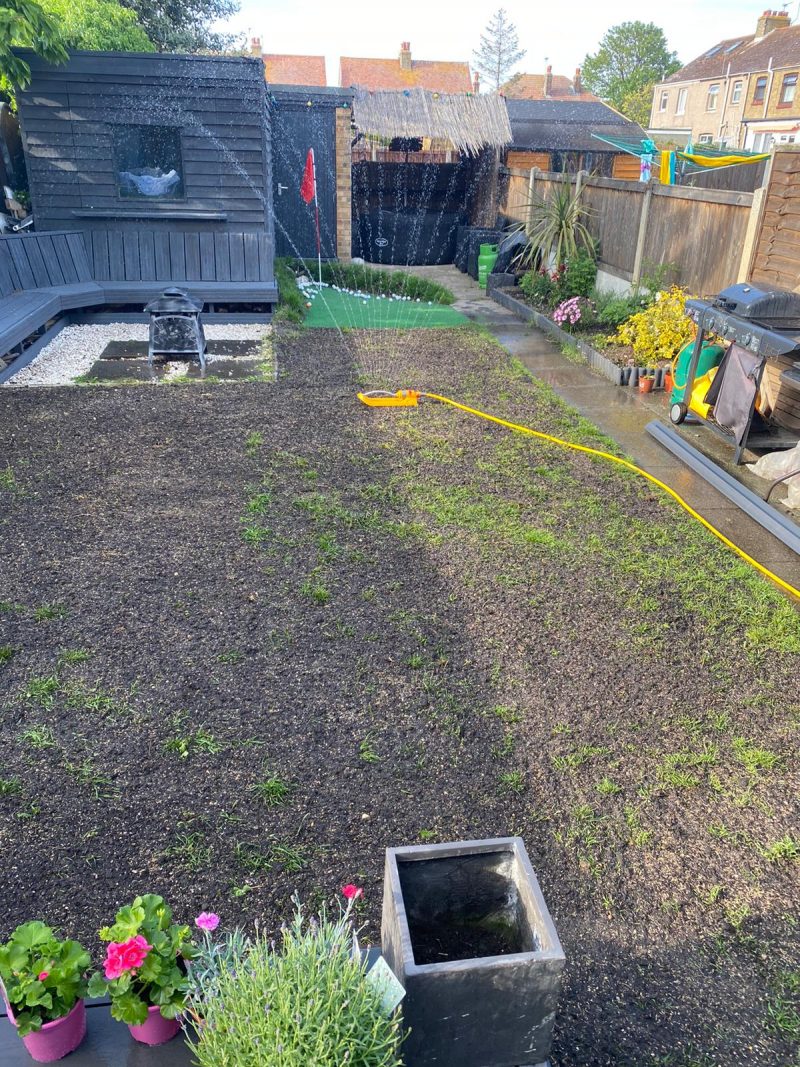
As you can see it’s starting to come through. Here is the full after I even tried to put a stripe in it 🙂
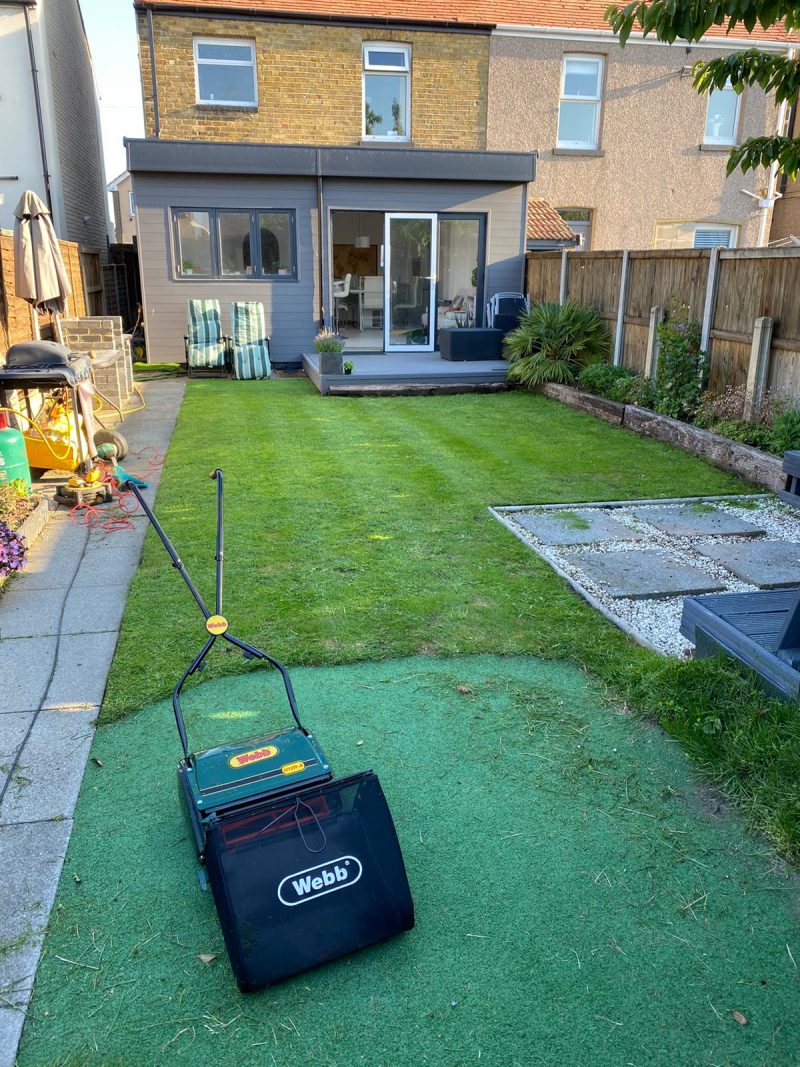
Further down in the how to sow a lawn I’ll show you the different stages that’ll help you build confidence yourself – the lawn actually took way less time to establish but getting it through nice and full took a little extra time 🙂
Today, you will learn all about the best grass seed for kids and pets, as well as other varieties that are fit for other purposes like patching up worn spots, or creating a bowling green-like back garden to make your neighbours green with envy and how to sow a lawn from too if you need help.
We’ll take about price, the pros and cons of different varieties, review the best grass seeds in the UK, and more. So, get yourself comfortable and let us show you everything you need to know about the subject.
If you’d like to get down to brass tacks and know our top picks for best pet and kid friendly lawn seed, here they are:-
Editors picks for the best grass seed in the UK:
Best grass seed overall: GBW grass seed – useful in so many situations I even used it on my own lawn from scratch.
Best grass seed for overseeding a thick lawn: GBW grass seed – The addition of a touch of brown top bent grass will give you a beautiful green surface.
Best grass seed for fast germination: Speedy Seed – if you want your grass to grow quickly, this is the seed for you.
Best seed for high traffic lawns: GroundMaster hard wearing seed – must have for people who’ve got pets and kids, this hardy stuff is just the ticket.
Best for clay soil: The Grass People seed – the deep roots of fescue, combined with perennial rye make this a winner for clay soil.
Best for shaded gardens: Gardeners Dream Shady seed Got tall trees casting shadows? Gardeners Dream shady seed should be the stuff you go for.
Best all-rounder: Miracle-Gro grass seed If you want a bit of an all round grass seed that’s good for most situations this is a good shout.
Help understanding the best grass seed for your lawn
If I could give you a simple answer to that question, then believe me I would, but it’s a tad more complicated than it first seems so apologies in advance for the length of this but there is quite a few considerations believe it or not!
There are literally dozens of different grass seed cultivars out there, each with their own properties that make them great for some gardens, and not so great for others. Explaining the differences between them all would take forever, but to make things simpler, we can break things down into the most commonly used grass species for lawns in the UK. You’ll find that most bags of grass seed that you buy will be a combination of these types of seeds:
Smooth stalked meadow grass
A favourite of turf growers, smooth stalked meadow grass is a good choice for people with kids and pets. This is because it will naturally spread out and start to grow in the bare patches that are created when your kids play on the lawn, or your dog decides to go digging.
Often paired with other seeds such as perennial ryegrass, which will germinate much faster, smooth stalked meadow grass will take its time to get settled and will take up to three years to cover a whole area. This is why using it in combination with other types of grass seed is how to get the most out of it.
Perennial ryegrass
Another popular turf grass, perennial ryegrass is extremely popular and common in UK gardens thanks to its fine leaves, tread resistance, and quick germination.
Like smooth stalked meadow grass, perennial ryegrass will form an underground network of stems called rhizomes, and then use them to spread across the lawn, helping to cover patches, albeit slower than some other grass seeds.
This type of grass is also very winter hardy, and will keep its lush green colour, but just be careful not to cut it too short, as it doesn’t seem to be too keen on that. Light shade doesn’t seem to be a problem for most perennial ryegrass cultivars, but they definitely thrive better in the sun.
Browntop bentgrass
If you want your lawn to look like a bowling green, Bentgrass is the way to go. You will have to spend more time taking care of it than with the other types of grass we’ve so far mentioned, and be on the lookout for fungal patch and spot diseases.
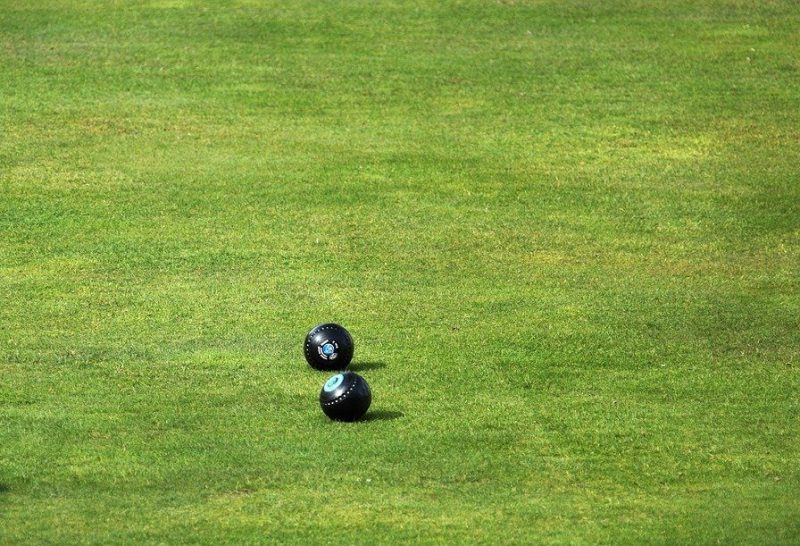
With proper care taken, Bentgrass seeds can grow into a beautiful thing, rewarding the owner with a dense and wonderfully soft lawn that can be cut extremely short. Want your own putting green in the back garden? Well, this is the stuff to buy.
Unfortunately, as well as being high maintenance, it isn’t the hardiest of grasses and unless you have a full-time professional gardener looking after it, or you have the skill and time to do it yourself, you’d be better off using a mix of Bentgrass seed and something like perennial Ryegrass or Fescue.
Poa supina
This slow growing grass is the one to go for if your lawn is overshadowed by trees and your home. It handles the shade better than pretty much any other type of grass, is hardy, and can cope with the colder temperatures that our winters bring around.
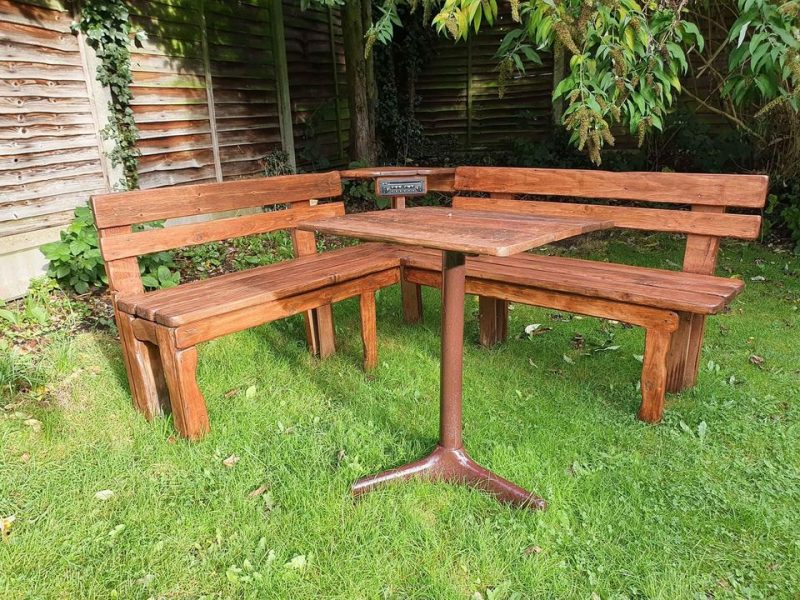
Although not really a lover of being cut too short, this grass can be trimmed down to around an inch or slightly lower without causing any damage to the turf. This shouldn’t need to be done that often either because, as we mentioned earlier, it’s not the fastest grower. It’s also not the most commonly sold, so you might have to hunt it down.
Fescue grasses
There are quite a few sub-types belonging to the fescue family such as hard fescue, creeping red fescue, and chewings fescue, but most are excellent for UK lawns thanks to their tolerance to shade and quick germination.
Fescue has fine leaves and can be cut very short, right down to 10mm in some cases, and this gives you a lawn that feels like a soft carpet to walk on in bare feet. Both creeping red and hard fescue are good choices if you live in a coastal area as they are not bothered by the salt in the wind.
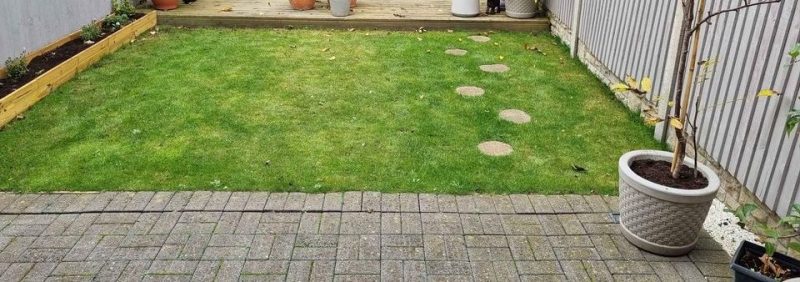
This type of grass will tolerate the UK’s winter conditions once established, but seeds will struggle to germinate unless given warm soil to do so in. As many fescue cultivars are drought resistant, it is fine to sow this kind of seed in spring to summer and avoid cold ground conditions.
How much will it cost to seed my lawn?
The cost of seeding your lawn with depend on a few different things, but the main ones are:
- Are you just overseeding a damaged lawn or reseeding a new one?
- How big is the area that you’ll be seeding?
- What kind, and quality, grass you’ll be sowing
For most people, doing a good job of overseeding is all that is needed to get their lawn back in good shape, and that will require between 30 and 50 grams of seed per square metre. If the patches aren’t too big or bald, try 30g, if your lawn looks like an ancient patchwork quilt, go for 40-50g.
Reseeding basically refers to creating a new lawn, and this has its own benefits and drawbacks that I won’t go into here. What I will say is that you’ll need about 70 grams per square metre in order to create a lush looking lawn.
Whichever method you are going for, try not to exceed the maximum weight of seed we recommend here or it can have adverse effects, and stop your lawn growing to its full potential.
Grass seed isn’t overly expensive, so I would advise not going for the cheapest stuff available. High quality seed can be purchased for about 15 quid for a 1kg bag, and as you only need around 30 grams for a square metre when overseeding, it’ll cover a decent area.
So, based on the average size of a lawn in the UK, you will probably need to spend about £30-£60 to overseed, and about a hundred pounds or so if you’re doing the whole thing from scratch. Obviously, this is a rough estimate, but it should be somewhere in that range. I just overseeded this 10m by 20m area for just over £100 with GBW grass seed and as you can see it’s starting to come through in patches. I’ll have to level the lawn soon with my beast lawn roller :D. – Sorry for the resolution I used my Ring security camera:

Which seed mix is best for a lawn with kids and pets?
We’d all love our lawns to stay in pristine condition but the reality for many of us is that kids, pets, and just general foot traffic cause a fair old bit of wear and tear.
With this in mind, it makes sense to lay down grass seed that will eventually grow into something that can handle this kind of punishment. Mixes that consist of perennial ryegrass and red fescue are the thing to go for here, and if you can find one that has a touch of smooth stalked meadow grass seed in there, it’ll really help with repairing patches in the future.
Now, just because a seed mix is advertised as good for pets, that doesn’t mean that you can let them walk over the area once it’s seeded, and you’ll have to wait for it to grow before your pets can lay there.
So, if you have a dog, you need to keep him on a leash in the garden, and if you’re worried about cats/foxes going in the area, some fox deterrents like these prickle strips can work well without hurting animal-
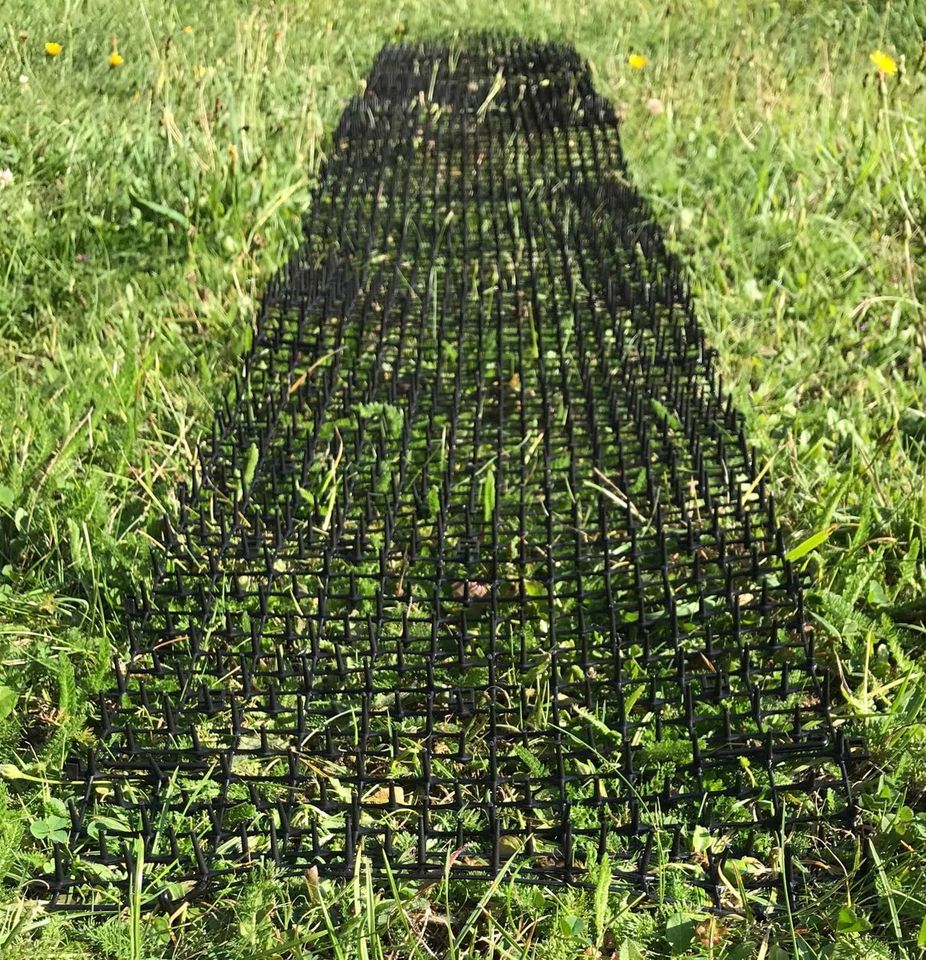
Which seed mix is the best for shaded gardens?
This depends on how much shade we are talking about here. For really shaded gardens, you’d be best off going with Poa bluegrass. It has proved time and time again that it just doesn’t mind living in the shadow of large trees and will thrive in any kind of water conditions. However, it’s lighter colour might not go that well with your current shade if you are overseeding or mixing.
For gardens that are not completely shaded, hardy seeds like perennial ryegrass and some fescue cultivars will be just fine. With these seeds, you will probably have to overseed once per year if the area is particularly shaded, but other than that, they are good choices.
Which seeds are better suited to UK garden soil?
The soil found in gardens in the UK varies a little from place to place, but the most common are clay, loam, and sand. How can you tell which one you have in your garden? Well, you can go get your hands dirty, as in literally.
- If you grab a handful of your wet soil and it feels like you could manipulate and shape it like kids’ playdough or plasticine, then it’s a fair bet that you’re dealing with clay soil and you’ll want to look at the The Grass People seed. In summer, when clay soil dries out, it is likely to show cracks on the surface.
Grass seed mixes that do well in clay soil are ones that contain perennial ryegrass, due to its extremely hardy nature, and fescues that root deep down in the soil, such as tall fescue.
- On the other hand, if you find that your garden soil won’t clump together at all and simply slips through your fingers, you’re probably dealing with sandy soil. This kind of soil doesn’t hold moisture or nutrients like clay soil does, and so you’ll need grass seed that is drought tolerant and I wouldn’t mind recommending looking at the GBW grass seed.
From my experience, the only types of grass that is a reliable grower in sandy soil are fescue variants. Strong creeping red fescue is a good choice, but you have to be patient with this slow germinating seed. Other good options are chewings fescue, and Sheeps fescue, which won’t mind the lack of nutrients.
- Loam soil is basically a combination of clay and sand, and this gives you the best of both worlds. It will hold enough water and nutrients, but also drain well so there’ll be no waterlogged lawn when we have a spell of downpours; an all too frequent thing in the UK, I’m sure you’ll agree.
If you’re lucky enough to have loam soil, then the world is your oyster, well the grass world anyway, and you can feel free to sow whatever seed you like. So, what are you waiting for? Take a look at the top grass seeds for sale in the following reviews section. If you’re still not sure about what type you have, then perhaps this video will help:
How to sow grass seed?
The title pretty much says it all but I couldn’t help throwing in just how in just how useful a lawn spreader is to purchase in combination with your grass seed. It’ll give you an easy way of ensuring a sensible even spread. With that out the way we should also look at the best time to plant grass seed and how long it’ll take to grow so you can be completely organised but before you do here’s a quick run through of the stages of a lawn I started from scratch:
I had a bit of a dig – not too deep then I levelled the ground as best I could with my garden roller and then used a rake to make the dirt nice and fine then used the trusty lawn spreader. A few weeks later I was watering and grass coming through.

A month or maybe a bit more after that the lawn had nearly come through. I noticed some low points so I filled with sand and took out the garden roller again. I added a bit of seed to the sandy areas for good measure:
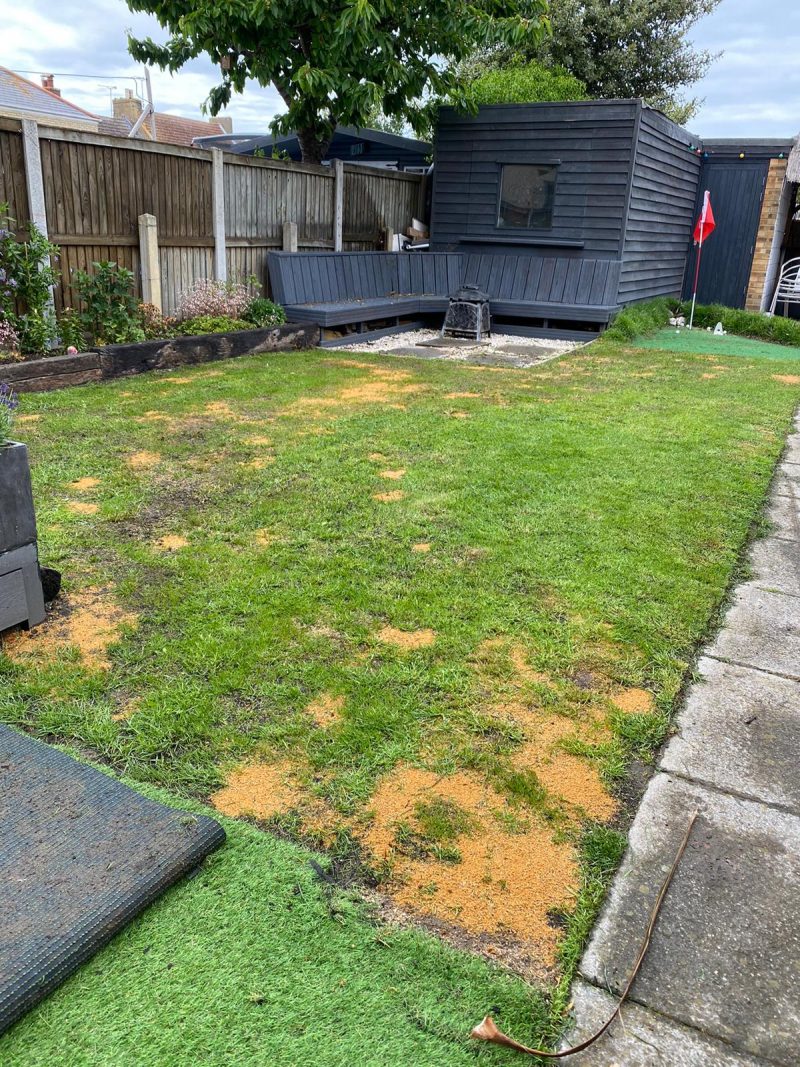
And as I showed you above the finished lawn after I tried to push a bit of a stripe in the lawn with my manual push mower:

When is the best time to plant grass seed?
In order for grass seed to germinate, the soil has to be above a certain temperature. What this means in layman’s terms is that you can sow your grass seed as early as March if the weather is warm enough, but it’s usually better to wait until April to be on the safe side.
You want to avoid planting grass seed in the middle of summer, but in late summer when things are still warm but not as hot as to damage the seeds through drought, you can feel safe to do so. Just make sure you’re giving them plenty of water.
How long does grass seed take to grow?
Under perfect conditions such as a lot of sunlight, but not overly hot temperatures, and plenty of rain, grass seed can take between one and three weeks to germinate. If conditions are not as perfect as you’d like, and they often aren’t, you will probably have to wait longer to see results.
So, just because your grass seed isn’t rewarding you with a velvety green carpet after a month, don’t fret, sometimes it takes a while for things to get going. The worst thing you can do is think you need to add more seed as sowing too much in a given area will have adverse effects.
As mentioned though, in absolutely ideal conditions, you can expect to see results in as little as a week, as this strangely satisfying time-lapse video shows:
Best grass seed for kids and pets reviewed UK
This is the part of the article where you get to know what grass seeds that we recommend for families that have kids and pets. Obviously, we have chosen mostly very tough mixes that can handle a little bit of punishment, but also tried to find ones that will give you that lovely looking lawn that you’re after, all year round.
1. GBW Grass Seed
For me, the ideal grass seed for the vast majority of people, is one that can withstand regular foot traffic, doesn’t need perfect weather conditions in order to continue to thrive, and rewards all the time you spent preparing your soil and tending to your seeds with a lush green lawn.
With GBW grass seed, that’s exactly what you get. The dwarf amenity ryegrass gives you an overall tough base that can handle shade and bad weather, and give weeds a hard time too. Red fescue and chewings fescue seeds are in there to help get those roots established, spread to bare patches, and cope with drought. Then there’s the brown top bent that will provide the softness and colour of a bowling green.
This is grass seed that really does what is claimed, although you have to be patient at first. It was over two weeks before we started to see some green shoots popping through the soil. Within a couple of weeks or so after that, the grass looked stunning.
There was one corner of the lawn that took a lot longer to grow than the rest as it was pretty much in constant shadow from a large shed, but eventually that patch too started to show signs of life, so top marks and two green thumbs up for the GBW grass seed from us.
If I was to pick a fault, it would be the packaging that the seeds come in. The bag is hard to open without causing damage to it, and so you are left to find a new container to keep any leftover seed in. A resealable bag would have been so much better.
Pros
- Good for fighting weeds
- Has the brown top bent seeds included for a beautiful colour
- Can cope with drought thanks to two fescue cultivars
- Will cover patches well if used to overseed
Cons
- Doesn’t grow as well in shade but will eventually establish itself
This is great choice if you’re looking to overseed a damaged lawn and add a bit more colour. For those of you who are unsure about overseeding and the results of doing t right, take a look at this video-
2. Speedy Grass Lawn Seed, 1.4KG Premium Quality
We all want grass seed that grows quickly, that’s a no-brainer. The faster the seeds germinate, the less time for birds to feast on them, and the quicker we can start nurturing them into a stunning patch of grass to enjoy with the family.
Advertisers know this, and so nearly all seed mixes will be touted as being fast growing and making claims that are rarely ever kept, such as ‘see results in 3 days.’ So, when I saw that this product was called Speedy Seed, I admit that I let my eyes roll a little, and when I read that I would see growth within a week to a fortnight I was dubious.
Well, I’m always happy to admit when I’m wrong (just don’t tell the wife I said that), and sure enough Speedy Seed is exactly that. The grass was clearly growing after about 9 days, and by the end of the month period, we were looking at a wonderful emerald lawn.
I’ve seen some negative feedback about this only being good as bird seed, and I’ll agree that the birds certainly took a liking to it, but that could be the case with any grass seed, and you have to make sure that you’re doing things to keep the winged raiders from eating it. If not, you’re going to see bad results. It’s that simple.
Pros
- Germinates quickly under the right conditions
- Can create a lovely green lawn within a month
- Deep roots can help with drought
- Good for reseeding a new lawn
Cons
- Birds seem to be very attracted to it, so you’ll need to find a way to deal with them
3. GroundMaster Hard Wearing Tough Garden Premium Back Lawn Grass Seed (5KG)
When you’re reseeding or overseeding a large area, you want to get a good deal on a large bag of seed or things will start to get a little pricey. Then again, that old saying of buy cheap-buy twice is always in the back of your mind too, so finding a good deal on quality seed that you can rely on is what you want.
Available to order in sizes ranging from 1kg to 25kg, with savings made on the larger orders, GroundMaster’s Hard Wearing Pro grass seed is the right choice for those bigger properties. The largest bag size is 5kg, so if you order 10kg or 15kg, you will get multiple bags. This has advantages and disadvantages, such as it’s easier to carry a 5kg bag than say a 10kg one, but it also means you’ll need to think about storage space.
With a mix of two different perennial ryegrass cultivars and creeping red fescue, the lawn you will get will be resilient enough for children and dogs once it’s grown, and if you sow at the right time, as in when the ground is warm enough, you’ll see some magic within 2-3 weeks.
If the temperatures are below 5 degrees, you will have to wait a bit longer until you see germination, and depending on circumstances this could be a month or even more. But, just give it time, and it will eventually start to grow into a thick, and very green lawn.
Pros
- Good price on large quantities
- Very resilient to pets and kids once grown
- Can handle high foot traffic
- Quick results are possible
Cons
- May take longer to germinate than you think if the weather is cold
We all know how much dogs love grass, and rolling on it after a bath, so having a tough type like ryegrass will prevent patches for when fido inevitably does this:
❄️🐶❄️
For a dog, rolling in grass after a frost is a bit like taking a cold shower! 🚿
It sets you up for the day! 😄#GoldenRetrievers 🐕😀🐾 #dogsoftwitter pic.twitter.com/fnVL10Nvu9
— Pip the Golden Retriever (@PipTheDog5) November 6, 2021
4. The Grass People Superstar: Back Lawn 10kg Grass Seed
A lot of first-time lawn seeders run into problems and often they can’t work out what exactly that problem is. The most common things that people do wrong are sowing seed when the weather is too cold, not protecting their newly sown seed from foot traffic, birds, and excitable pets, and trying to grow the wrong kind of grass for their soil type.
I already explained this in our introduction, but I know some of you will have skipped all that and jumped straight to the reviews, so I’ll repeat it here- basically, don’t try to grow an ornamental grass like brown top bent if you have thick clay soil.
For clay soil, you need either pure perennial ryegrass, or a mix that has a high percentage of ryegrass in it, and that’s why I recommend this stuff from The Grass People. Available in either 10kg or 20kg amounts for very reasonable prices, the combination of 80% perennial ryegrass and 20% creeping red fescue is just the stuff you need to handle those soil conditions.
What’s more, when it grows it will be very resilient to pets and kids, and general foot traffic as long as you keep your mowing to between 25mm-40mm and don’t go shorter. Under the right conditions, you should be giving your new lawn its first ‘haircut’ by about 6 weeks after you originally sowed
I would avoid trying to grow this seed in summer as dry and hot weather will not give you the results you’re looking for. Likewise, colder periods are not great either and ideally, you want to sow in March when the ground frost has gone, through to May or early June. Alternatively, you could try mid to late September, but it would depend on the weather conditions of that particular year.
Pros
- Great choice for clay soil
- Resilient enough for kids and dogs
- High percentage of tough perennial ryegrass seeds
- Fairly priced, especially in larger amounts
Cons
- Avoid sowing this seed in hot weather or very cold conditions
Clay soil can be improved for growing grass if you know what you are doing, and this clip gives a few tips on this:
5. Gardeners Dream Shady Lawn Grass Seed - 5KG
Having a heavily shaded garden can make reseeding or overseeding a lawn problematic if you don’t pick the kind of grass seed that can handle those conditions. To compound the problem those tricky advertisers are at it again, claiming that products are good for shady gardens when they are not.
As you have probably guessed from the name, Gardeners Dream Shady lawn grass seed has been designed to grow in shady gardens, and contains a mix of two different types of fescues- creeping red and Chewings. This combination actually works really well, and your grass will grow even in full shade.
However, don’t expect this to be an overnight thing, and even in near perfect conditions it took a few weeks before we saw what we wanted to see. I half expected this though, as I know more about fescues and how they grow than the average person, but if you’re new to this, please be patient.
There were one or two patches that didn’t grow as well as the rest of the lawn, but there are tons of reasons why this could be, such as birds feasting on seed in that area, the soil conditions, or simply due to human error when spreading the seed. I usually use a seed spreader for sowing lawns, but on this particular day, I forgot it and did it by hand.
Overall. I have to say that this is a well-priced grass seed that works well for gardens that are overshadowed by trees or the neighbouring buildings. It does take some time to get established, but grows well in the end and produces a nice, soft lawn that can be cut down fairly short.
Pros
- Excellent option for people with shaded gardens
- Combination of fescues helps with both shade and drought
- Will spread to cover bare patches over time
- Well- priced for quality seed
Cons
- Can take a while to germinate and establish itself into a quality looking lawn
Even a smallish sized tree like the one in the photo can cast a constant shadow over a patch of grass, so if you have shaded areas, pick yourself a good shade resistant seed type.

6. Miracle-Gro 119612 EverGreen Multi-purpose Grass Seed
Miracle-Gro’s multi-purpose grass seed is another fast-germinating option for both overseeding a damaged lawn, or starting off a new one. Providing you get the conditions right, that is.
Like with the Gardeners Dream product we reviewed above, you’re going to have to get your timing right in order for the Miracle-Gro seed to live up to the brand’s claims, but I have to say that it is possible to get germination to occur within a week or so.
Where this seed sort of falls a bit short is in shaded areas, and we saw a noticeable difference in how well the grass grew in the light compared to the patches in shadow. This isn’t exactly surprising, but something to keep in mind if you have a lot of shaded spots in your garden.
As with most kid and pet friendly grass seeds, this one is a mix of perennial ryegrasses and fescues and will be hard wearing once it’s grown. The fescue seeds will take a little longer to establish their roots, but will do a cracking job of spreading to bare patches later, so hang in there.
I’d say that this product is very good if given the right conditions and a bit of time, but it doesn’t seem to do very well in the shade. It can germinate quite quickly, although the 5-day claim is probably reaching a bit, from what I’ve seen anyway.
Pros
- Trusted brand name that’s been around for years
- Quick to germinate
- Combination of hard-wearing grass seeds that’ll be good for families with pets and kids
- All-purpose seed and is good for both overseeding and reseeding
Cons
- Doesn’t grow well in the shade























